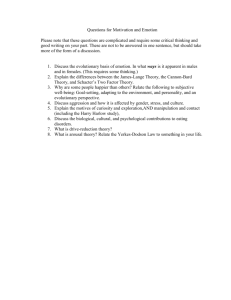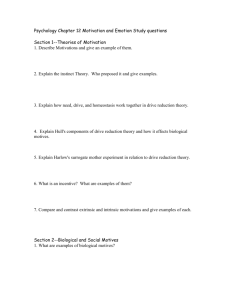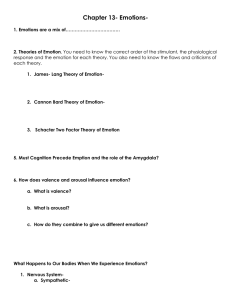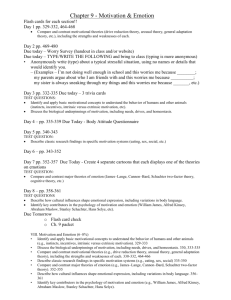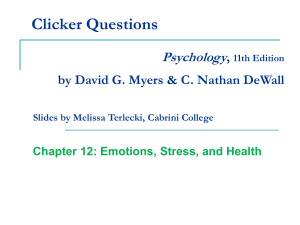Emotions - Alphonse Asylum
advertisement
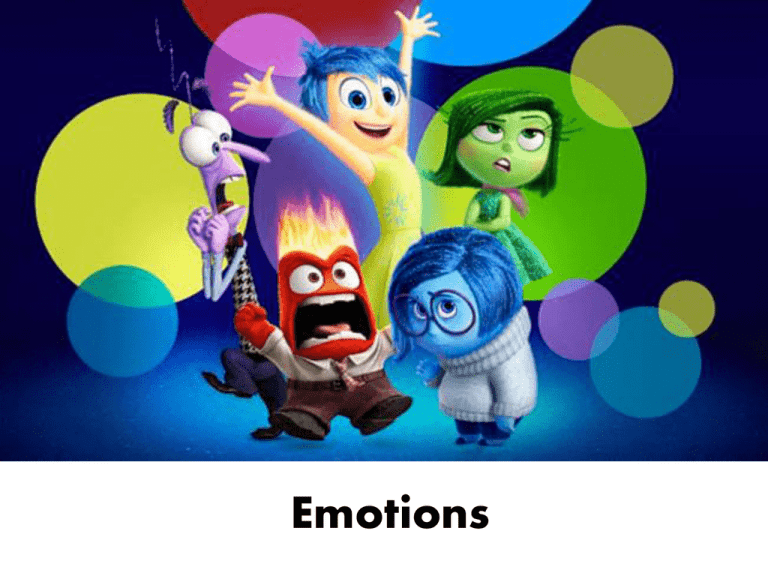
Emotions Essential Task 8-7: • What are emotions? • Theories of Emotion – James–Lange Theory – Cannon–Bard Theory – Cognitive Appraisal Theory – Schachter Two-factor theory – Opponent Process Theory Emotion • The experience of feelings • Can activate and affect behavior but it is more difficult to predict the behavior prompted by a motivation James-Lange Theory William James and Carl Lange proposed an idea that was diametrically opposed to the common-sense view. The James-Lange Theory proposes that physiological activity precedes the emotional experience. James-Lange theory Body = emotion “Without the bodily states following on the perception, the latter would be purely cognitive in form; pale, colorless, destitute of emotional warmth. We might then see the bear, and judge it best to run... But we should not actually feel afraid.” (William James, 1890) James, 1890, v. 2, p. 449 (Gleitman) James-Lange theory James-Lange theory • Situation bodily reaction emotion FEAR or LOVE? Spill over effect An arousal response to one event spills over into our response to the next event. Spill over effect Arousal from a soccer match can fuel anger, which may lead to rioting. Arousal fuels emotion, cognition channels it. Proposes that physiological activity precedes the emotional experience. Proposes that physiological activity precedes the emotional experience. Cannon-Bard Theory Walter Cannon and Phillip Bard questioned the JamesLange Theory and proposed that an emotion-triggering stimulus and the body's arousal take place simultaneously. Cannon-Bard Theory • See snake, run and fear simultaneous • Stimulus to thalamus -- sends simultaneous messages to: – Lymbic system (arousal) – Cortex (fear) Schachter-Singer Theory Two-Factor Theory Stanley Schachter and Jerome Singer proposed yet another theory which suggests our physiology and cognitions create emotions. Emotions have two factors– physical arousal and cognitive label. “Schacter Factor!” The Schachter theory • Situation bodily reaction emotion + cognitive appraisal FEAR LOVE 3. The Schachter theory • Testing the theory: • Hypothesis: The same bodily reaction will cause one emotion in one situation, and another emotion in a different situation. – Give people a dose of adrenaline; – Put them in different situations; – What happens? 3. The Schachter theory • Testing the theory: • Schachter & Singer 1962: (didn’t take pill) (know what pill does) VERY ANGRY! Medium angry! Least angry VERY EXCITED! Medium excited! Least excited Due on Friday, January 15th (It is excellent review! )
